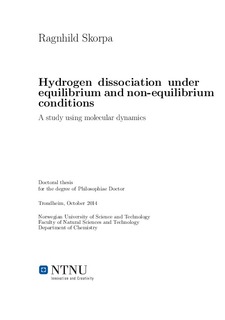| dc.contributor.author | Skorpa, Ragnhild | |
| dc.date.accessioned | 2015-03-12T08:48:51Z | |
| dc.date.available | 2015-03-12T08:48:51Z | |
| dc.date.issued | 2014 | |
| dc.identifier.isbn | 978-82-326-0558-3 (printed ver.) | |
| dc.identifier.isbn | 978-82-326-0559-0 (electronic ver.) | |
| dc.identifier.issn | 1503-8181 | |
| dc.identifier.uri | http://hdl.handle.net/11250/278949 | |
| dc.description.abstract | The aim of this thesis project was to model reactions using classical molecular
dynamics simulations under both equilibrium and non-equilibrium conditions and
to study the effect of the reaction on the transport properties of the system. The
dissociation of hydrogen was chosen as a model system based on its importance
for the hydrogen society, and the availability of interaction potentials to model the
reaction.
According to procedures described by Stillinger andWeber, a three-particle interaction
potential was added to the pair potential. With this it was possible to properly
describe the dissociative reaction. Equilibrium studies was performed at different
temperatures and densities. From this, a detailed analysis of the interaction potential,
the pair correlation functions and the contributions from the two- and three
particle interactions on the overall pressure was performed. This made it possible
to determine a temperature and density range where the degree of dissociation was
significant.
The Small System method was extended to calculate partial molar enthalpies from
fluctuations of particles and energies in a subsystem embedded in the simulation
box. It was proven that this method worked well for both reacting and nonreacting
mixtures. This method was applied to the hydrogen dissociation reaction.
From this the reaction enthalpy was determined as a function of temperature,
pressure and composition of the reacting mixture for three different densities. The
reaction enthalpy was found to be approximately constant (460–440 kJ/mol) for
a gas (0.0052 g/cm3), 410–480 kJ/mol for a compressed gas (0.0191 g/cm3) and
500–320 kJ/mol for a liquid (0.0695 g/cm3) for temperatures in the range 4000-
21000 K. With knowledge of the reaction enthalpy, the thermodynamic equilibrium
constant, and thus the deviation from ideality was found.
Non-equilibrium simulations was used to study the coupled transport of heat and
mass both transport of hydrogen through a palladium membrane and for the dissociative
reaction in a bulk phase. For the first case, transport coefficients had to
be estimated. For the latter case, the coefficients were determined for the first time
directly from the fluxes in the system using non-equilibrium molecular dynamics
simulations. The transport properties for both systems were then determined from
the coefficients. For transport across a membrane, it was illustrated how a temperature gradient could be used to enhance and control the flux of hydrogen through
the membrane | nb_NO |
| dc.language.iso | eng | nb_NO |
| dc.publisher | NTNU | nb_NO |
| dc.relation.ispartofseries | Doctoral thesis at NTNU;2014:323 | |
| dc.relation.haspart | Paper 1:
Skorpa, Ragnhild; Voldsund, Mari; Takla, Marit; Schnell, Sondre Kvalvåg; Bedeaux, Dick; Kjelstrup, Signe.
Assessing the coupled heat and mass transport of hydrogen through a palladium membrane. Journal of Membrane Science 2012 ;Volum 394-395. s. 131-139 <a href="http://dx.doi.org/ 10.1016/j.memsci.2011.12.033" target="_blank"> http://dx.doi.org/ 10.1016/j.memsci.2011.12.033</a> | |
| dc.relation.haspart | Paper 2:
Skorpa, Ragnhild; Simon, Jean-Marc; Bedeaux, Dick; Kjelstrup, Signe.
Equilibrium properties of the reaction H2=2H by classical molecular dynamics simulations. Physical Chemistry, Chemical Physics - PCCP 2014 ;Volum 16.(3) s. 1227-1237 <a href="http://dx.doi.org/ 10.1039/c3cp54149e" target="_blank"> http://dx.doi.org/ 10.1039/c3cp54149e</a> | |
| dc.relation.haspart | Paper 3:
Schnell, Sondre Kvalvåg; Skorpa, Ragnhild; Bedeaux, Dick; Kjelstrup, Signe; Vlugt, Thijs J.H.; Simon, Jean-Marc.
Partial molar enthalpies and reaction enthalpies from equilibrium molecular dynamics simulation.
The following article appeared in Journal of Chemical Physics 2014 ;Volum 141.(14) s. 144501 and may be found at <a href="http://dx.doi.org/ 10.1063/1.4896939 " target="_blank"> http://dx.doi.org/ 10.1063/1.4896939 </a> | |
| dc.relation.haspart | Paper 4:
Skorpa, Ragnhild; Simon, Jean-Marc; Bedeaux, Dick; Kjelstrup, Signe.
The reaction enthalpy of hydrogen dissociation calculated with the Small System Method from simulation of molecular fluctuations. Physical Chemistry, Chemical Physics - PCCP 2014 ;Volum 16.(36) s. 19681-19693
<a href="http://dx.doi.org/ 10.1039/c4cp02768j" target="_blank"> http://dx.doi.org/ 10.1039/c4cp02768j </a> | |
| dc.relation.haspart | Paper 5:
R. Skorpa, T. J. H. Vlugt, D. Bedeaux and S. Kjelstrup. Di_usion of
heat and mass in a chemically reactive mixture.
Is not included due to copyright. | |
| dc.title | Hydrogen dissociation under equilibrium and non-equilibrium conditions A study using molecular dynamics | nb_NO |
| dc.type | Doctoral thesis | nb_NO |
| dc.subject.nsi | VDP::Mathematics and natural science: 400::Chemistry: 440 | nb_NO |

